Introduction
Background of Study
The key objective of this research paper is to analyze the role of leadership in a complex and global hospitality industry. In order to do so, this paper selects Marriott Hotel International in order to discuss the affect of leadership on this global organization. Marriott International Inc is the global giant of hospitality industry with successful record of accomplishment in more than seventy counties with 34000 locations along with 192,000 associates and franchise outlets and globally established an assortment of landmark branding such as Marriott, JW Marriott, Ritz-Carlton, Autograph-Collection, Renaissance, Residence Inn, Courtyard, TownePlace Suites, Fairfield-Inn, SpringHill Suites, along with Bulgari and so on.
According to Yahoo finance (2011), it is essential to note that Marriott International Inc is a US-based business with headquarters in Bethesda, Maryland that continuously focuses on improvement, runs vacation-ownership motels below Marriott Vacation-Club, Ritz-Carlton-Destination-Club, and Grand-Residences administrating entire ownership of housing-brands, comprising Ritz-Residences, JW-Marriott, etc; in addition, the corporation runs Executive-Apartments, supplies fully equipped corporate-housing, conference-centers, and many others.
Research Question and Objectives
Many scholars provide the leadership model to skills, knowledge, and experience to achieve organisational goals, but these models do not provide appropriate solution most of the cases because the organization would not try to find out route of the problem. Therefore, the aim of this research paper is to answer subsequent questions and to identify the attitude of the employees of Marriot Hotel with theoretical framework of leadership, motivation, staff turnover and so on.
What is the importance of leadership in hospitality organisation;
How the hospitality organisation can motivate staffs to reduce staff turnover;
To identify what actions considered most appropriate to improve the performance of the staff of Marriott Hotel.
Scopes of the study
- The researcher has opportunity to gather organize the paper based on solid experience gathered through survey;
- One of the main scopes of this study is to explore the implications of implementing team learning and within the branches of Marriott International Hotel;
- In addition, the author has scope to focus on the employee turnover issue, job satisfaction aspects, motivation, communication, diversity management, team learning, and team effectiveness that remains value-adding concern to the organisation, development of performance, and effect of wage rate on the job satisfaction, and so on;
- Identify the challenges and opportunities related with leadership is also an important issue to address;
- Moreover, it is also essential to discuss the room for improvement, identify the dissatisfied employees, and the effects of negative employee attitude on the Marriott International Hotel;
- Most importantly, this paper has enough scope to conduct a real research to know the attitude of the employees as well as the top-level management to analyse the selected topic.
Limitations of the Study
The researcher has suffered following problems to organizing the paper with proper research, such as –
- Total word limit was not sufficient to analyze all the every issue related with leadership, motivation, job satisfaction, staff turnover and so on;
- In addition, the deadline to conduct survey was not sufficient to collect primary data from the employees and top level management of the Marriott International Hotel;
- Collecting data for the respondents was difficult task because both management and employees were too busy with their own Job;
- Furthermore, lack of budget was another important concern to the author because it should require huge fund to gather both secondary data (books, official documents, and journal articles) and primary data from respondents.
Literature Review
Motivation in Hospitality Industry
In the hospitality industry, motivation refers to directing the employees’ effort to a particular objective and it is a significant tool for achieving the organizational goals and objectives; furthermore, some motivational theories and approaches have developed in the field of stimulus process, some of which has listed below:
Equity Theory
This has based on the supposition that people wants to be treated fairly in relationship to others; outcome refer to the reward in terms of salary, benefit, and bonus that employees receive from the hospitality organization that motivate them towards work;
Need Hierarchy Theory
This hypothesis has developed by Abraham Maslow that plays a significant role to motivate the employees; it has been assuming that every employee has five levels of needs that require fulfilling chronologically and fulfillment of one give raise to another – this has illustrated in the following figure:
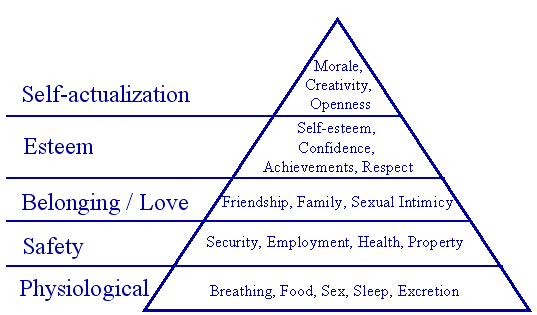
Motivation-maintenance approach
This motivation theory implies that managers of hospitality organizations cannot motivate the employees – rather, motivation comes from the work factors like the work environment of the hospitality industry (Robbins and Judge, 2008);
Expectancy Approach
This indicates that the motivation of the employees depends on three factors that are expectancies, instrumentality, and valence; the hospitality industry should predict the level of belief of the employees that directly affect the motivation and try to increase that level of belief, so that they could motivate to achieve the objectives.
Leadership in Hospitality Industry
West and Tonarelli-Frey (2010, p.358) stated that leadership is significant to the hospitality organization because it is one of the main aspects that contribute positively to the success of hospitality organization; so it emphasized to use emotional and inter personal and communication skills in order to influence the achievement of organizational objectives. Chathoth and Olsen (2002) good leader will seek to create unity in pursuit of the organizational goal while manager will mainly concentrate on mounting the output by management activities, so, good leader has to focus on staff motivation, communication systems, training process, and succession plan in the organization.
Theories and styles of leadership
Adair’s Action Centered Leadership Model
John Adair established most recent and the widely used representation of the role of a leader in the world “Action Centered Leadership” model based on human needs and motivation by Maslow, Herzberg and Fayol, and he added that leadership is a trainable, transferable skill, and different from management. However, the following figure shows its attributes –
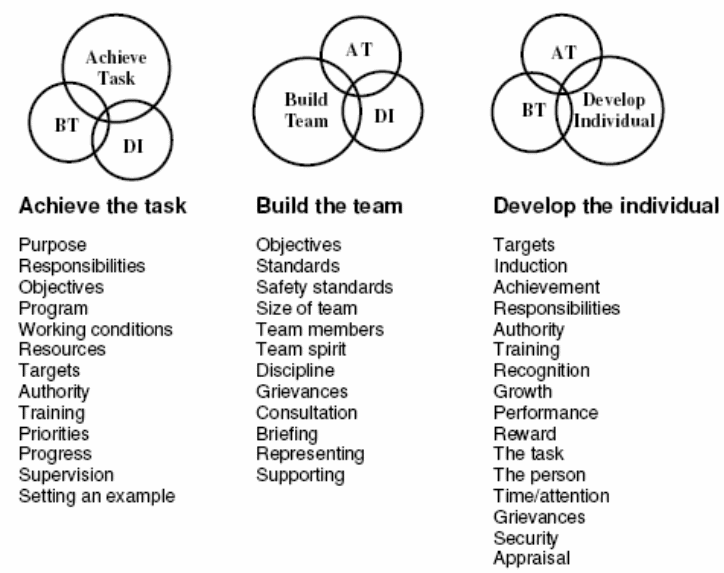
Belbin’s Theory
Chong (2007) stated nine roles theory can maintain by the team members of the company, so, Hospitality organisation can adopt this theory and Belbin theory recommended that –
Plant Role
Plant role refers to the ability of the team members to show creativeness, imagine the situation, and solve the difficult problem;
Coordinator Role
The team leaders should exhibit the maturity in work and decision-making to reach the objectives,
Monitor, Evaluator Role
These roles are perfect for the team leaders in hospitality industry;
Great Man Theory
According to the Katzenbach and Douglas (2003), this theory indicates that the leadership has identified as an attribute, which carried out by birth rather than gaining through practice or learning;
Trait Theory
The fundamental assumption of this theory shows that some leaders have some inbuilt personalities and influential characteristics, and these traits especially well fitted for the conquering leadership.
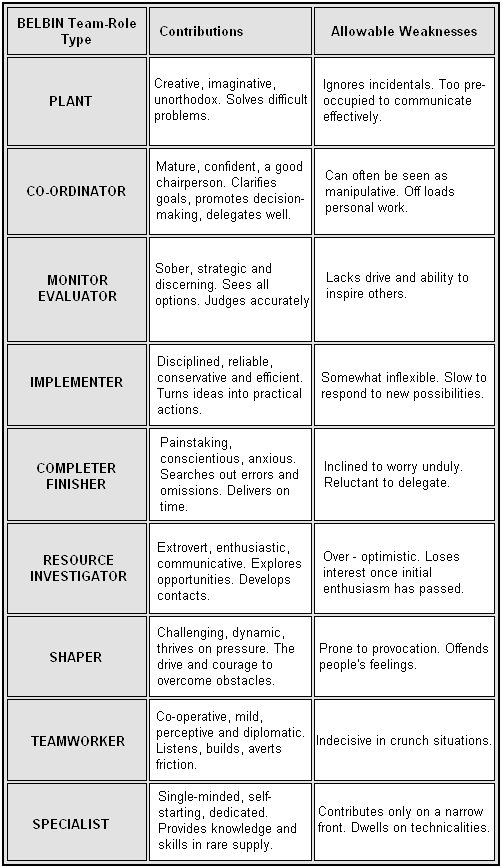
Implementer Role
The leaders mostly concentrate on the implementation of the plans;
The Role of Completer
This role refers to the completing and finishing the specific task or the whole projects;
Other Roles
However, the other rules include resource investigator role, sharper role, teamwork role and specialist role.
Undertaking Strategies to Reduce Employee Turnover
Employee turnover is a significant area for a hospitality organization due to high administrative cost burden as well as reduction of productivity; turnover can occur through various ways and in most of cases, it might be either voluntary or involuntary as shown in the figure below:

In order to ensure successful leadership in a globally diversified and complex hospitality organization, it is quite essential to focus more on the retention of expatriate employees; the following motivational strategies have usually undertaken:
- Equal opportunity: scope of equal opportunity in the working atmosphere has aimed to protect discriminations including racial practices;
- Confidentiality: HRM department of an organization has to be committed to protecting privacy of the candidate’s personal information during recruitment process;
- Scope of collective bargaining and compensation: collective bargaining option has clarified all the entire terms and conditions, which would ease the applicant to join in a hospitality organization;
- Recruitment of relatives: some hospitality organizations provide a few opportunities of jobs for the employment of relatives;
- Cultural Diversity: this involves the leaders to emphasize more on cross-cultural issues.
Research Methodology
Introduction
The basic objective of this chapter is to analyze how the paper will be formulated by applying proper research method, selecting survey methods, questionnaire designing, and so on. However, it would be easy to the researcher to carry on the research by following six major steps of Malhotra instead of Yin’s case study approach though this research paper will consider a single case.
Research Approach
Malhotra (2009, p.81)and Saunders, Thornhill & Lewis (2006) stated that there are mainly two study approaches, such as, quantitative and qualitative research approach. To organize this research paper, the author will focused on both research approaches while the initial one involves seeking an opportunity to quantify data by implementing some statistical module like- survey questionnaire and the last one is an exploratory and unstructured process using small sample for providing general insights of the research problems.
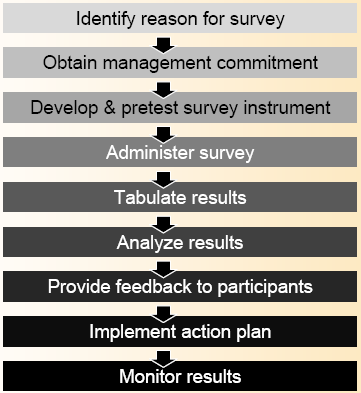
Primary research
Cohen, Manion & Morrison (2007) expressed that collection of primary data is the most complicated task for the research paper, but Marshall and Rossman (1999) pointed out that primary data collection is one of the most important task to explicit motive or determine the research gap to get solution. However, the author of this research paper has decided to gather primary data from the general ranked employees and top-level management of Marriott International Hotel to gather knowledge about their attitudes. However, the following table demonstrates more information about target respondents –
Table 1: – Selected Respondents for interview. Source: Self generated.
Secondary Research Approach
Secondary data analysis is important as these data has already published, and recognized by the renowned authors (Saunders, Thornhill, and Lewis, 2006). On the other hand, Zikmund (2006) and Malhotra (2009) mentioned that secondary processed data are more authentic to serve the current purpose, because the publishers, universities, and other academia approved these sources.
Field survey or Data Collection process
Miles and Huberman (1994) and Sekaran (2006) expressed that face-to-face interviewing method is the most effective method as there is no chance to complete the survey form with the third person. However, the researcher has to use more instantaneous method (like email, phone or fax) to avoid delay because direct interview is useful if the researcher get sufficient time.
Questionnaire Design
According to the view of Malhotra (2009, p.281) and Sekaran (2006), findings and conclusion chapters based on the outcome of the survey report; as a result, designing a simple questionnaire is important and there is no specific rule to prepare a questionnaire. Therefore, the author has opportunity to design it in accordance with the research dilemma or goals. In addition, the researcher will use his creativity to design it and he also go through academic reports, previous research, books, and other web sources on the related issue in order to get a clear idea about the leading a complex hospitality organization. Table two provide more information about the questionnaire –
Table 2: – The questionnaire design process. Source: – Self generated.
Data Analysis process
At the initial stage of data analysis process, the researcher will edit the survey report to clean all the errors and then he will compare the result of survey with the secondary data. After editing the survey reports, all the result will be graphically represented in the finding chapter of this research paper by using Microsoft excel software. On the other hand, the author will find out useful secondary data after proper study that it will fit with the research arena to organize literature review and other chapters.
Limitation of Data Collection Process
Shortage of budget, lack of sufficient time to prepare plan to conduct research, contact with top-level management, review and edit the paper to eliminate unintentional mistakes, and find out the relevant secondary resources were the key problems of the data collection procedure.
Findings and Results
The questionnaire was handed over to 50 interviewees of Marriott Hotel where 10 respondents were from the top-level management and the rest 40 was from the employees. The key idea of the findings chapter is to examine the results of the actual survey to assess and evaluate how to lead a complex and globally diverse hospitality organization.
Part A: Introduction with the Respondents
Question 1a): – Name, Address, and Phone number of the Respondents
This was a general question essential to introduce with the respondents of the survey.
Question 1b): – Years of experience of the Respondents
Identifying the experience altitude of the respondents is essential in the assessment process of results as it helps to determine the most accurate and reliable answers; additionally, the survey suggested that the numbers of respondents with experiences below five-years and with experiences between five to ten years are more than that of employees who are experienced for over fifteen years. Among all the respondents, 50% respondents had an experience of less than 5 years, 30% respondents had experience between 5 and 10 years, and 20% respondents had experience for more than 15 years.
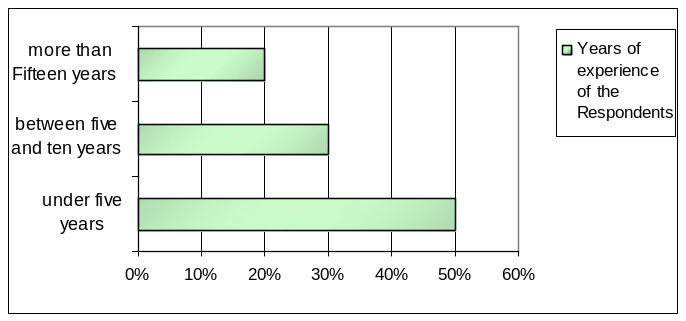
Question 1c): – The job position of the interviewees
This general question has asked with the intention to distinguish the existence of the respondents working at different of job positions, as a better understanding about this will assist the research work by identifying the foremost dependable feedbacks; in so doing, the researcher tried to concentrate on various job ranks by taking 20% respondents from top-level management and 80% employees.
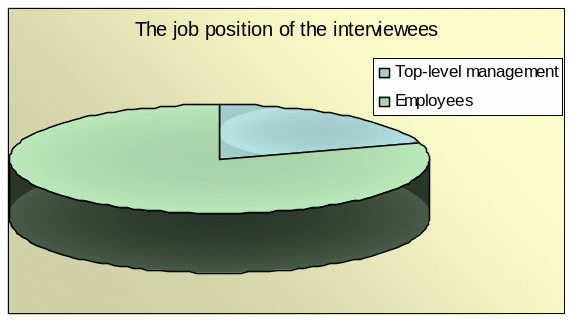
Part B: Respondents’ View
Question 2: – Is strong leadership important to manage the company
As an answer to this question, the majority of the respondents from the Marriott Hotel have argued that they agree strong leadership to be important to manage the company. About 20% of the respondents have agreed to this fact, whereas 60% have strongly agreed to this and 10% stayed neutral. On the other hand, 10% respondents have disagreed to this argument, but no one has strongly disagreed to this. This has illustrated in the following figure.
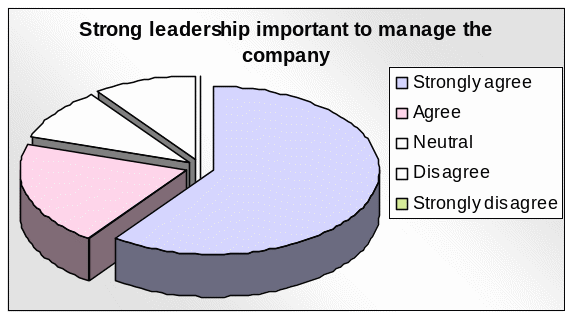
Question 3: – Do profitability of an organization depend on staff turnover
Many interviewees haves argued that profitability of an organization, to a large scale depend on staff turnover. About 50% respondents have agreed to this statement, whereas 30% have strongly agreed, and none of them stayed neutral. Conversely, 10% people have suggested that they disagree to this point of view, whereas the rest 10% have strongly disagreed to this.
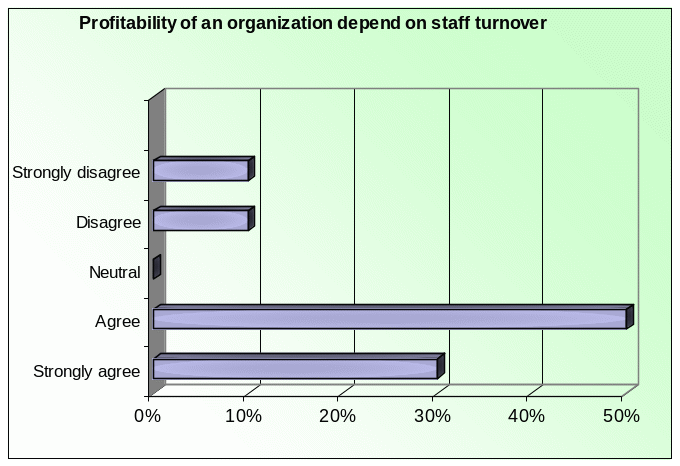
Question 4: – Is communication problem one of the main reasons to increase staff turnover at hospitality organizations
There has been a mixed reaction to the answer of this question. Some of the interviewees have identified that they agree that communication is problem one of the main reasons to increase staff turnover at hospitality organizations, whereas others have disagreed to this. Among 50 interviewees, 30% have suggested that they agree about the statement, whilst 30% have strongly agreed to this and 20% remained neutral. On the other hand, 10% interviewees were disagreeing to the proposed question, with the rest 10% strongly disagreeing.
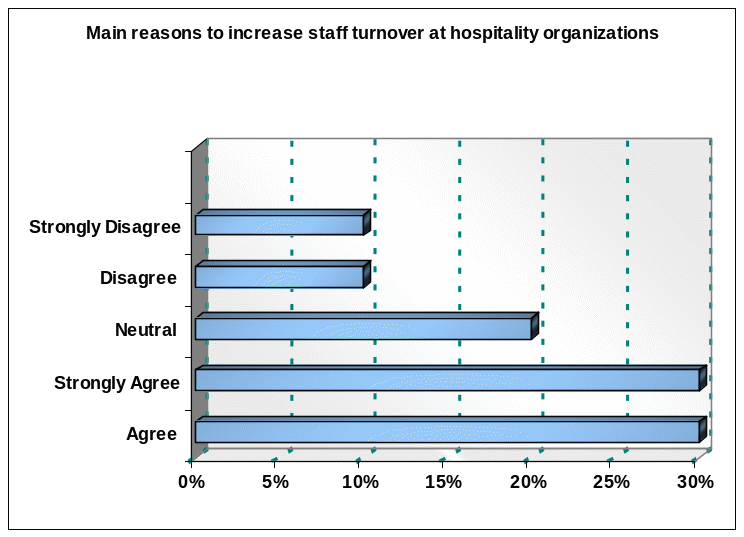
Question 5: – Whether high wage rate can decrease the staff turnover at hospitality organizations or not
It is arguable that about 30% interviewees suggested their approval to the fact that high wage rate can decrease the staff turnover at hospitality organizations, with about 40% saying that they strongly agree to the statement. Apart from that, it was surprising to find out that about 20% of the interviewees have remained neutral in providing the feedbacks. Moreover, 10% respondents have disagreed to this argument, whilst no one has strongly disagreed to this. It is important to say that the majority of the agreements to the proposed question were coming from the part of the employees, whilst the highest number of disagreement came from the part of the top-level managers.
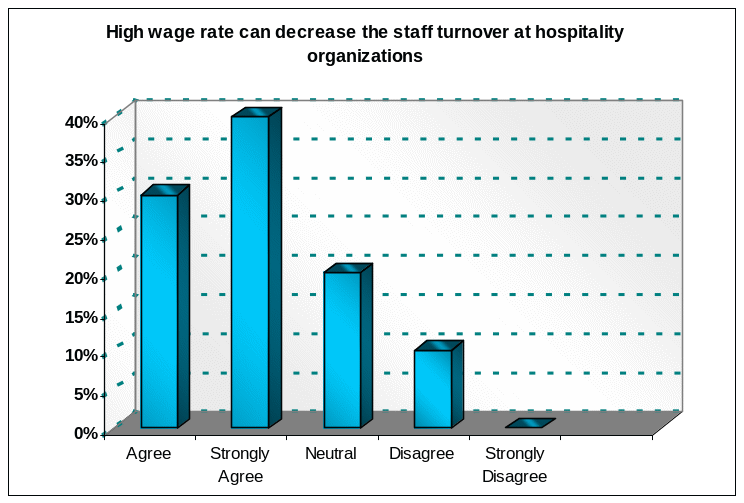
Question 6: Whether motivation can play vital role to increase the service quality or not
In the context to the above asking, it can be argued that motivation is one of the main elements that can play a vital role to increase the service quality, as because this is the most essential tool that can improve the leadership instinct among the top management of the Marriott Hotel by increasing working spirit amongst workers. About 20% of the surveyed population came up with the idea that they agree with the asking of the researcher, whereas about 60% have strongly agreed to it and 10 percent remained neutral. Conversely, about 10% respondents have provided their disagreements to this point of view, but none of them has strongly disagreed to this.
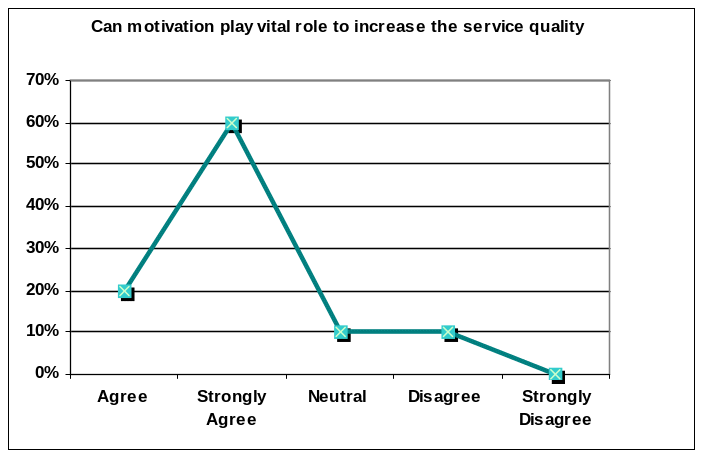
Question 7: – Whether management should concentrate on the team learning or not
From 50 respondents, 30% have agreed with the above statement, whereas 30% have strongly agreed, and 20% have stayed neutral. In a similar way, 10% of the surveyed population have disagreed to the statement, with the rest 10 percent strongly disagreeing to it. However, it is imperative to note that team learning, in reality, put a great deal of effort over enhancing organizational skills.
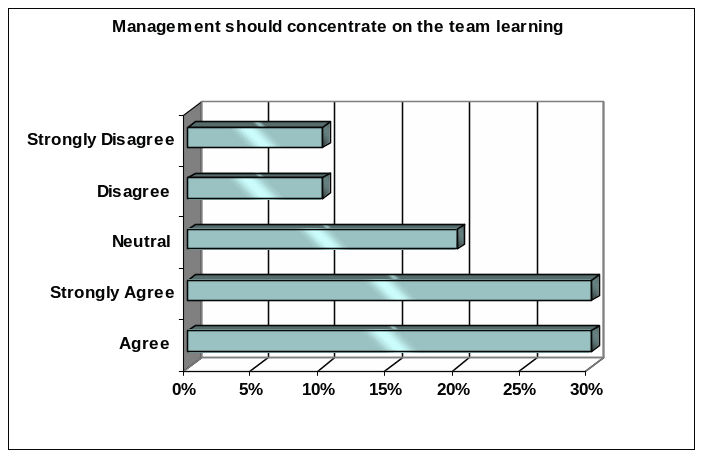
Question 8: – Whether appropriate recruitment and selection process is also a vital issue or not
In a large number of instances, appropriate recruitment and selection process remains a vital issue in retaining and motivating employees in the Marriott Hotel (Hall, 2010). Therefore, a range of feedbacks has received from this question with 10% interviewees agreeing that appropriate recruitment and selection process is a vital issue, and 20% saying that they strongly agree to the viewpoint. Conversely, 10% interviewees remained neutral to the question with 40% disagreeing and 20% strongly disagreeing to the statement.
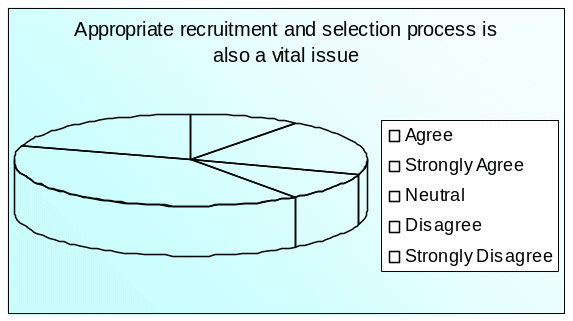
Question 9: – Whether ensuring effective workplace environment is also a vital issue or not
It is essential to argue that 40% of the surveyed population believes effective workplace environment as a vital issue. In a similar context, about 10 percent of the respondents have strongly agreed to the point of view, with 10% staying neutral and 20% disagreeing to this. In opposition, the rest 20% have strongly disagreed to the asking of the researcher.
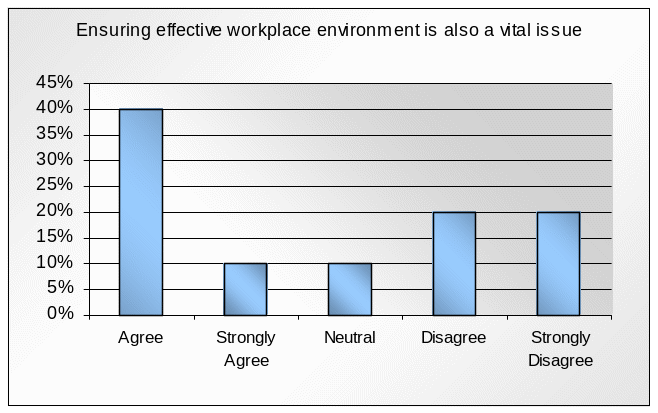
Question 10: – Whether high satisfaction can ensure high performance or not
A large number of the respondents have agreed to the assertion. As per the survey, 30% respondents agree to the point that high satisfaction can ensure high performance. Likewise, 20% have strongly agreed to this and 20% remained neutral. Conversely, 20% interviewees disagreed to the viewpoint, and merely 10 percent have strongly disagreed to it.
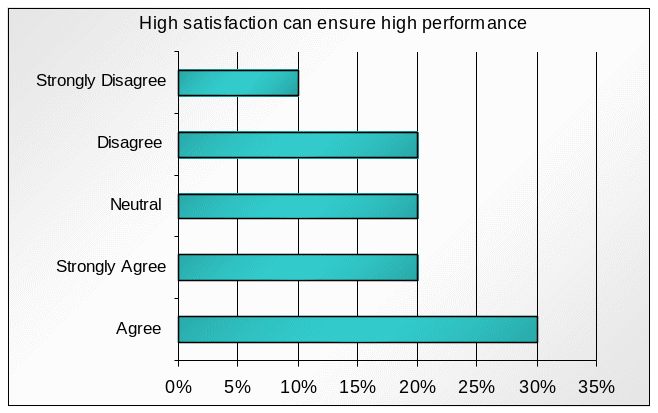
Conclusion
Recommendations
- Most of the managers argued that high satisfaction does not ensure high performance, but the staff stated that high satisfaction is an essential factor to show better performance. Therefore, it should require to concentrate on other issues to improve performance level;
- Before attempt to select the expatriates for an particular post, the recruiter team of Marriott International Hotel should communicate properly (open dialogue) with the candidates to know about their motivational stage and this process is important in order to select expatriates for the organization;
- The management should try to identify both interpersonal and intercultural communication problems of the staff at the recruitment stage, and should select those candidates who have genuine interest in this sector, ability to match environment of the hotel, have advance language skills, enthusiasm to study, and competent to handle stressful situation;
- Moreover, staff turnover is one of the significant issues for the Hotel, because it can pinpoint a leadership problem; as a result, theme of leadership needs to adjust and the leaders should be highly educated to control the administration by introducing participative approach;
- The management should also focus on payment structure, equal opportunity in all sector, job skills, innovation, and supervision of the performance;
- Leader should ensure that the required skills and understanding is available in the colleagues to initiate the change;
- The Leader always monitors the change process in the organisation and motivate the colleague on positive changes that will bring high confidence among the staff;
- In order to leading this complex, global hotel, the management of Marriott International Hotel has to consider the survey reports to find out the impact of workplace environment on the staff, the reason of turnover, organisational politics, organisational culture, and the present position of this Hotel.
Conclusion
Marriott Hotels is one of the most multifaceted and internationally assorted organizations of the hospitality industry. In assessing such an organization, the researcher has put emphasize over the leadership of the organization together with providing a clear view about the process that the leaders undertake to reduce staff turnover, face the main challenges, manage expatriates and handle cultural diversity.
Reference List
Chathoth, P. K. & Olsen, M. D. (2002) Organisational Leadership and Strategy in the Hospitality Industry. Web.
Chong, E. (2007) Role balance and team development: A study of team role characteristics underlying high and low performing teams. Web.
Cohen, L., Manion, L. & Morrison, K. (2007) Research Methods in Education. 6th ed. New York: Routledge.
Hall, C. (2010) Marriott Hotels Case Study. Web.
Katzenbach, J. R. & Douglas, S. (2000) The Wisdom of Teams: Creating the High-Performance Organization. Global Learning Communities.
Loquercio, D. (2006) Turnover and retention: Literature review prepared for People in Aid. Web.
Malhotra, N. K. (2009) Marketing Research- An Applied Orientation. 5th ed. Prentice-Hall of India Private Limited.
Marshall, C. & Rossman, G., (1999) Designing qualitative research. 3rd ed. Thousand Oaks – CA: Sage.
Miles, M. & Huberman, M. (1994) Qualitative Data Analysis. 2nd ed. Beverly Hills, CA: Sage.
Robbins, P. S. & Judge, A. T. (2008) Essentials of Organizational Behavior. London: Pearson Prentice Hall.
Rowstrom, J. W. (2011) Organizational Behavior: Human Behavior at Work. 3rd. London: The McGraw-Hill Companies.
Saunders, M., Thornhill, A. & Lewis., P. (2006) Research Methods for Business Students. 4th ed. London: FT Prentice Hall.
Sekaran, U. (2006) Research Method for Business. 4th ed. John Wiley & Sons, Inc.
West, J. & Tonarelli-Frey, S. (2010) Leadership in the hospitality industry. Web.
Yahoo finance (2011) Marriott International, Inc. (MAR). Web.
Zikmund, W. M. (2006) Business Research Methods. 7th ed. Orlando: Harcourt Publishers.